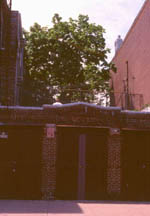

Tree Removal & Replanting: A Stitch in Time Saves Nine!
At this time, the only accepted official means of dealing with trees having any signs of ALB in the US is to cut down all infested trees, chip and burn all of the wood, and grind the stump (research on chipping). The Science Advisory Panel endorsed this protocol in 1996. Even trees with only one exit hole visible on a branch must be removed because authorities believe it is likely that other less conspicuous parts of the tree are infested. As of January 2001, over 5,000 trees have been removed in the New York area, and almost 1,500 in Chicago, IL. Considering that both known ALB infestations are located in metropolitan areas, this strategy has been a sad but necessary action. Many of these trees have graced the lives of these families for several generations. However, it is generally recognized that if these infested trees were allowed to stand, not only would they serve as a source of further infestations, they would be ultimately killed by the beetle anyway.
Tree removal has been difficult and expensive in these urban environments, which are cluttered with cars, people and power lines. According to the ALB quarantines, infested trees can only be removed by tree care specialists who have been certified by the state. This ensures that the strict guidelines associated with destroying the trees are followed. Many of the infested trees in New York were growing in enclosed courtyards surrounded by 3-4 story apartment buildings. These trees had to be cut down piece by piece and carried out through apartments. In some heavily infested areas, all of the mature maple trees on shady urban streets had to be removed, leaving a barren streetscape. 
ALB infested tree in
Greenpoint, Brooklyn.
Tree removal by
chipper (APHIS photo)
A few homeowners have resisted the mandate to remove infested trees. One homeowner in New York refused to allow his heavily infested birch tree to be removed because he insisted that it be replaced with a healthy tree of the same species. According to guidelines established by the US Dept. of Agriculture, only tree species that are not ALB hosts can be replanted (USFS list of non host species for Chicago) It took several months to obtain a court order to remove the tree, and during that time, several trees on adjacent properties became infested and also had to be destroyed. During the early phases of the ALB eradication program, funding from the Forest Service has been provided for replacing some of the trees that were cut down in New York and Chicago.
|
|
|